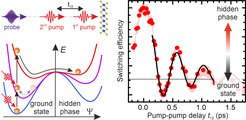Hidden Phases in Quantum Materials: A Key to the Next Generation of Data Storage
The 21st century is the Age of Data. In our modern, data-driven world, we need better ways to store data. Current technologies, like magnetic recording, are reaching their limits. However, new materials, called quantum materials, could provide exciting new ways to store data.

One way these materials could be used is through something called metastable hidden states. These are states that can only be reached by using very short optical or electrical pulses. However, despite intense research, the fundamental processes that govern the dynamical pathway to hidden phases remain a largely open subject.
An international team of physicists from Fritz Haber Institute of the Max Planck Society, the Jožef Stefan Institute in Ljubljana, the Stanford University, and the Technical University in Berlin has been studying these hidden states in a specific quantum material. They used extremely short laser pulses to trigger these states and then studied the electrons inside the material.
They found that the transition into the hidden state happens very quickly. They also noticed that the vibrations of the material's structure play a big role in this transition. If these vibrations are strong enough, they can cause the material to enter the hidden state.
The team also found that they could control these vibrations, and therefore the transition into the hidden state, by using a second excitation laser pulse. This discovery marks an important step in the understanding of hidden phases, a prerequisite for using these quantum materials for data storage.
The beat of the lattice
More specifically, the team investigated the hidden state in the prototypical quantum material 1T-TaS2. They applied ultrashort optical and extreme ultraviolet (XUV) laser pulses much shorter than a trillionth of a second (picosecond) in a stroboscopic experiment, and recording the photoelectrons emitted by the XUV laser pulse using a technique called time- and angle-resolved photoemission spectroscopy (trARPES), which provides a direct view onto the electrons moving inside the material during the transition.
The finding of a surprisingly fast transition into the hidden phase, in conjunction with prominent oscillations of the electron signatures suggested a decisive role of coherent, collective lattice vibrations in the phase transition – i.e. a concerted lattice oscillation set in motion by the ultrashort laser pulse. This vibration – when excited strongly enough – introduces a large amount of disorder into the material, which provides the right conditions for the emergence of the hidden phase.
To further proof the importance of these oscillations for the phase transition, they next used a multi-pulse optical excitation scheme, where a second pump laser pulse either enhances or suppresses the lattice oscillations depending on their delay. The high degree of coherent control over the switching process to the hidden phase found in these experiments provides compelling evidence for the key role of the collective amplitude mode as the driver of the transition.












